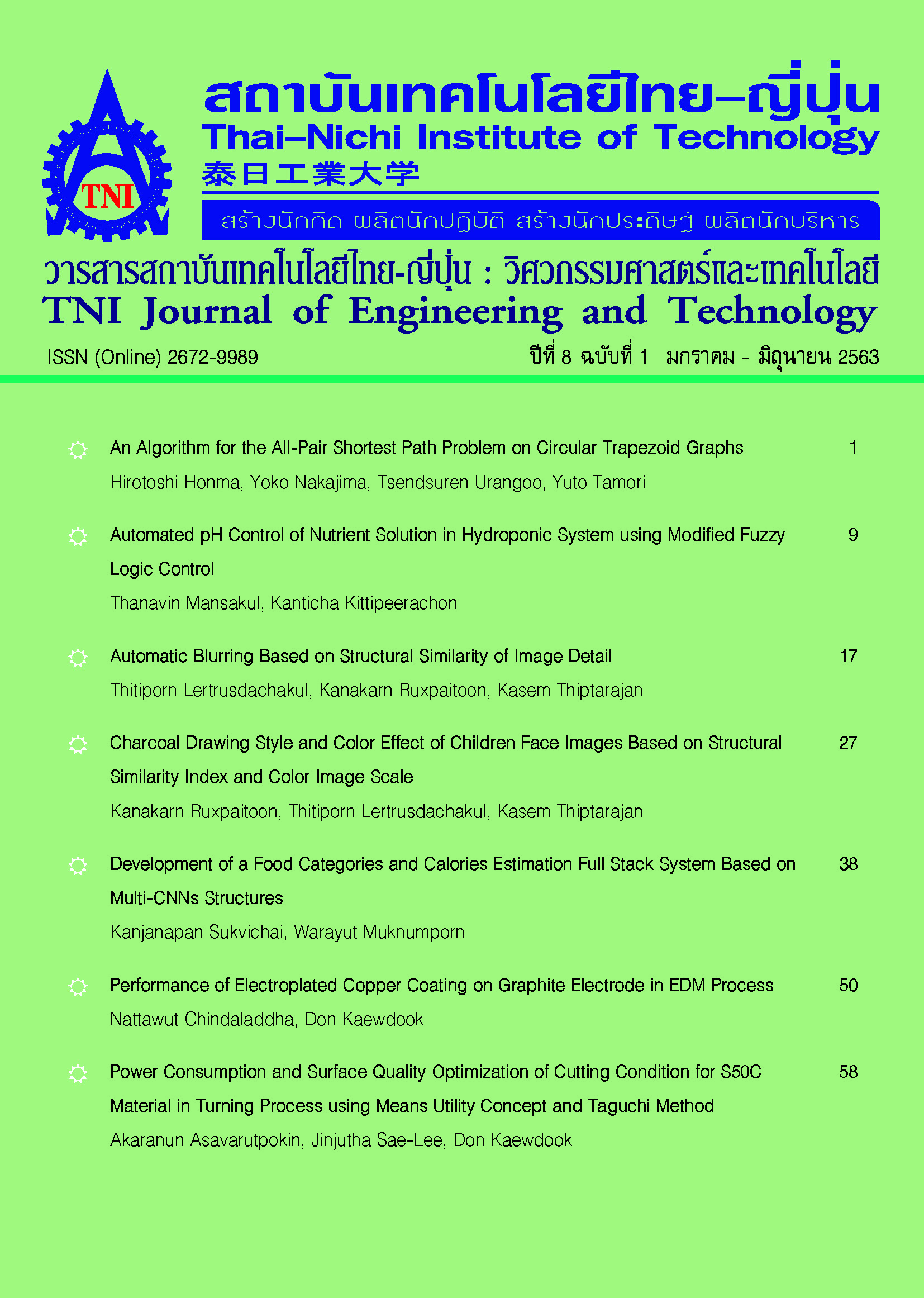Automatic Blurring based on Structural Similarity of Image Detail
Main Article Content
Abstract
Image smoothing is used for a variety of purposes such as removing noise, feeling enhancement, drawing attention to the object. Since the images have different details, they require an appropriate blur level for their contents and applications. Therefore, this research studies and develops automatic blurring method to increase depth impression of image. The blur levels are divided into large blur (very shallow depth of field) and small blur (preserve image structure). The method applies image quality assessment of structural similarity index (SSIM) to measure blur level between images. Only the SSIM values of image detail which affects the blur perception of human are used to compare with the values of appropriate blur levels from preliminary experiment of 100 images. The technique isolates the detail of image in SSIM map by using Otsu’s thresholding method. With the proposed approach, blurred images of both levels can be automatically created to enhance the focus to the key subject of image. The evaluation result from photography expert reveals that the proposed method can assist well in creating dimension of image, time saving of image editing especially for those who are not skilled in art.
Article Details
Article Accepting Policy
The editorial board of Thai-Nichi Institute of Technology is pleased to receive articles from lecturers and experts in the fields of engineering and technology written in Thai or English. The academic work submitted for publication must not be published in any other publication before and must not be under consideration of other journal submissions. Therefore, those interested in participating in the dissemination of work and knowledge can submit their article to the editorial board for further submission to the screening committee to consider publishing in the journal. The articles that can be published include solely research articles. Interested persons can prepare their articles by reviewing recommendations for article authors.
Copyright infringement is solely the responsibility of the author(s) of the article. Articles that have been published must be screened and reviewed for quality from qualified experts approved by the editorial board.
The text that appears within each article published in this research journal is a personal opinion of each author, nothing related to Thai-Nichi Institute of Technology, and other faculty members in the institution in any way. Responsibilities and accuracy for the content of each article are owned by each author. If there is any mistake, each author will be responsible for his/her own article(s).
The editorial board reserves the right not to bring any content, views or comments of articles in the Journal of Thai-Nichi Institute of Technology to publish before receiving permission from the authorized author(s) in writing. The published work is the copyright of the Journal of Thai-Nichi Institute of Technology.
References
G. Mather, “The use of image blur as a depth cue,” Perception, vol. 26, no. 9, pp. 1147-1158, Sep. 1, 1997.
M. Gawron and U. Boryczka, “Heterogeneous fog generated with the effect of light scattering and blur,” JACS, vol. 26, no. 2, pp. 31-44, Oct. 2019.
R. Liu, Z. Li, and J. Jia, “Image partial blur detection and classification,” in 2008 IEEE Conf. on Computer Vision and Pattern Recognition, Anchorage, AK, USA, 2008, pp. 1-8.
D. Yang and S. Qin, “Restoration of partial blurred image based on blur detection and classification,” Journal of Electrical and Computer Engineering, pp. 1-12, Jan. 13, 2016.
P. Shivakumara, B. S. Anami, and G. H. Kumar, “A new structural no-reference rule based blur metric for classification of blurred home photos,” ECTI-EEC, vol. 7, no. 1, pp. 73-81, Feb. 2009.
U. Ali and M. T. Mahmood, “Analysis of blur measure operators for single image blur segmentation,” Appl. Sci., vol. 8, no. 5, pp. 1-32, May 17, 2018, doi: 10.3390/app8050807.
S. Pertuz, D. Puig, and M. A. Garcia, “Analysis of focus measure operators for shape-from-focus,” Pattern Recognition, vol. 46, no. 5, pp. 1415-1432, May 2013.
K. De and V. Masilamani, “Image sharpness measure for blurred images in frequency domain,” Procedia Engineering, vol. 64, pp. 149-158, 2013.
S. A. Cholewiak, G. D. Love, and M. S. Banks, “Creating correct blur and its effect on accommodation,” Journal of Vision, vol. 18, no. 9, pp. 1-29, Sep. 2018.
X. Luo, N. Z. Salamon and E. Eisemann, “Controllable motion-blur effects in still images,” IEEE Transactions on Visualization and Computer Graphics, vol. 26, no. 7, pp. 2362-2372, 2020, doi: 10.1109/TVCG.2018. 2889485.
Adobe, “How to add blur to a photo in Adobe Photoshop,” ADOBE.com. https://www.adobe.com/creativecloud/photography/discover/blur-image.html (accessed Feb. 14, 2020).
BeFunky, “Photo blurring with a focus on quality,” BEFUNKY.com. https://www.befunky.com/features/blur-image/ (accessed Feb. 14, 2020).
Fotor, “Easily blur images with powerful blur photo editor,” FOTOR.com. https://www.fotor.com/features/blur.html (accessed Feb. 14, 2020).
Z. Wang, A. C. Bovik, H. R. Sheikh, and E. P. Simoncelli, “Image quality assessment: From error visibility to structural similarity,” IEEE Transactions on Image Processing, vol. 13, no. 4, pp. 600-612, Apr. 2004.
N. Otsu, “A threshold selection method from gray-level histograms,” IEEE Transactions on Systems, Man, and Cybernetics, vol. 9, no. 1, pp. 62-66, Jan. 1979.


